Artificially bred fish species are introduced to the Yangtze River to improve biodiversity. Li Lei reports from Beijing, with Liu Kun in Yichang, Hubei.
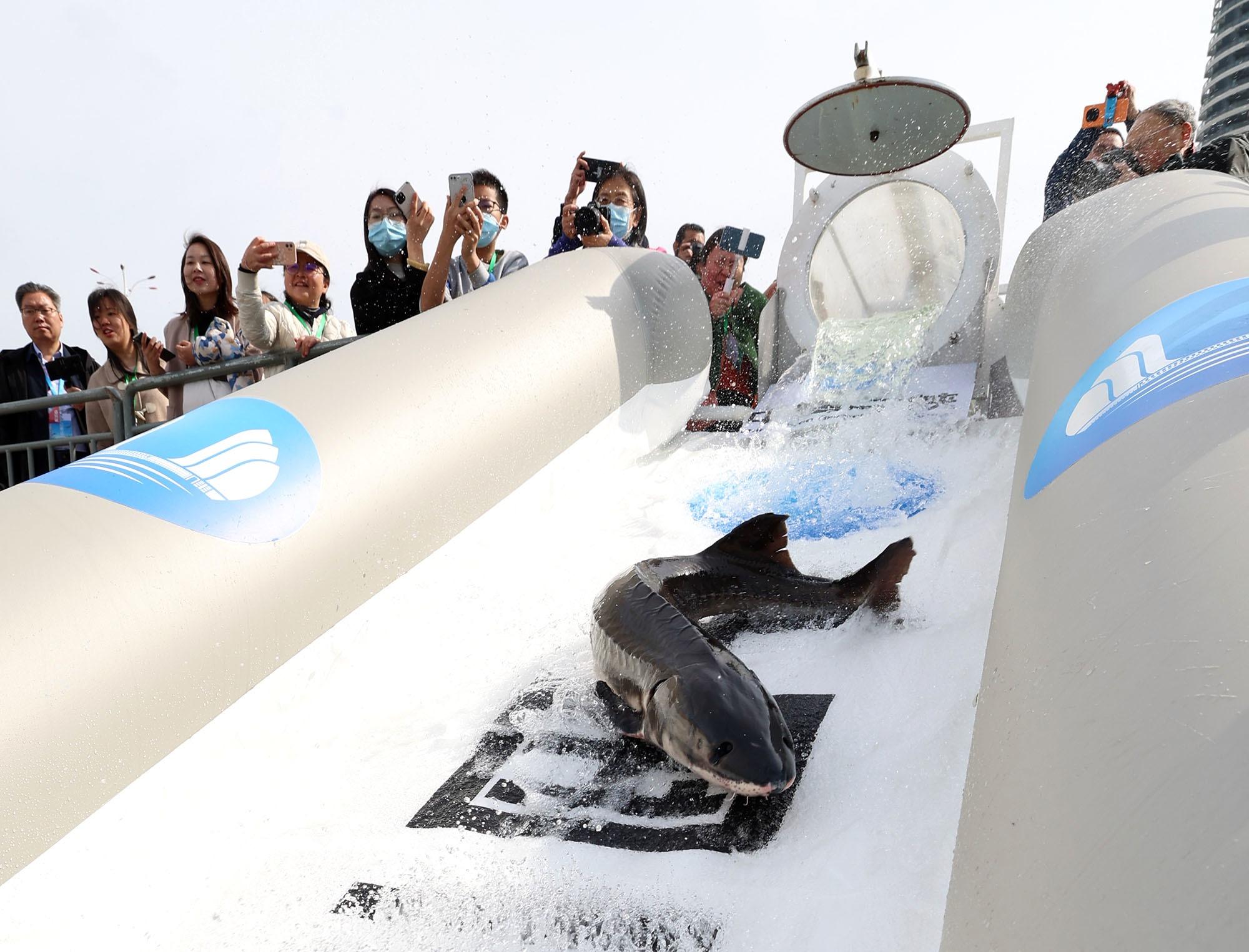 An artificially bred Chinese sturgeon is released into the Yangtze River in Yichang, Hubei province, on March 26, 2023. (PHOTO / XINHUA)
An artificially bred Chinese sturgeon is released into the Yangtze River in Yichang, Hubei province, on March 26, 2023. (PHOTO / XINHUA)
Editor's note: As protection of the planet's flora, fauna and resources becomes increasingly important, China Daily is publishing a series of stories to illustrate the country's commitment to safeguarding the natural world.
On a sunny day, hundreds of volunteers swarmed along the banks of a stretch of the Yangtze River in Yichang, Hubei province, in Central China.
A vessel owned by the China Fishery Law Enforcement, a bureau with the Ministry of Agriculture and Rural Affairs, which is overseeing a decadelong fishing ban imposed in 2021 to restore the river's biodiversity, docked nearby. The workers embarked on a gargantuan task: to release about 230,000 Chinese sturgeons into the waterway, the natural spawning ground of the fish.
One after another, young sturgeons were gently placed on a slide. They slid down five slides that stretched deep into the water, the nation's mother river.
The slides bore bold Chinese characters that spelled out the name of the event's organizer — the China Three Gorges Corp, which operates the dam of the same name some 40 kilometers upstream and also funds a research center to ensure that such releases are successful.
The Chinese sturgeon is known for the bony, armor-like scute covering its scales, and is often referred to as a "living fossil" due to its long evolutionary history and physical characteristics that have remained relatively unchanged over millions of years.
In China, the fish — whose life expectancy can reach 40 years — is a beloved national treasure on a par with the giant panda. Although it is classified as a critically endangered species, the fish used to travel long distances from the sea to breed in freshwater rivers, including the Yangtze. However, naturally spawned sturgeons have become increasingly rare, making the release of artificially bred fish important.
"I was excited to see the fish raised with my own hands released into the wild," said Jiang Wei, chief engineer at the Chinese Sturgeon Research Institute in Yichang.
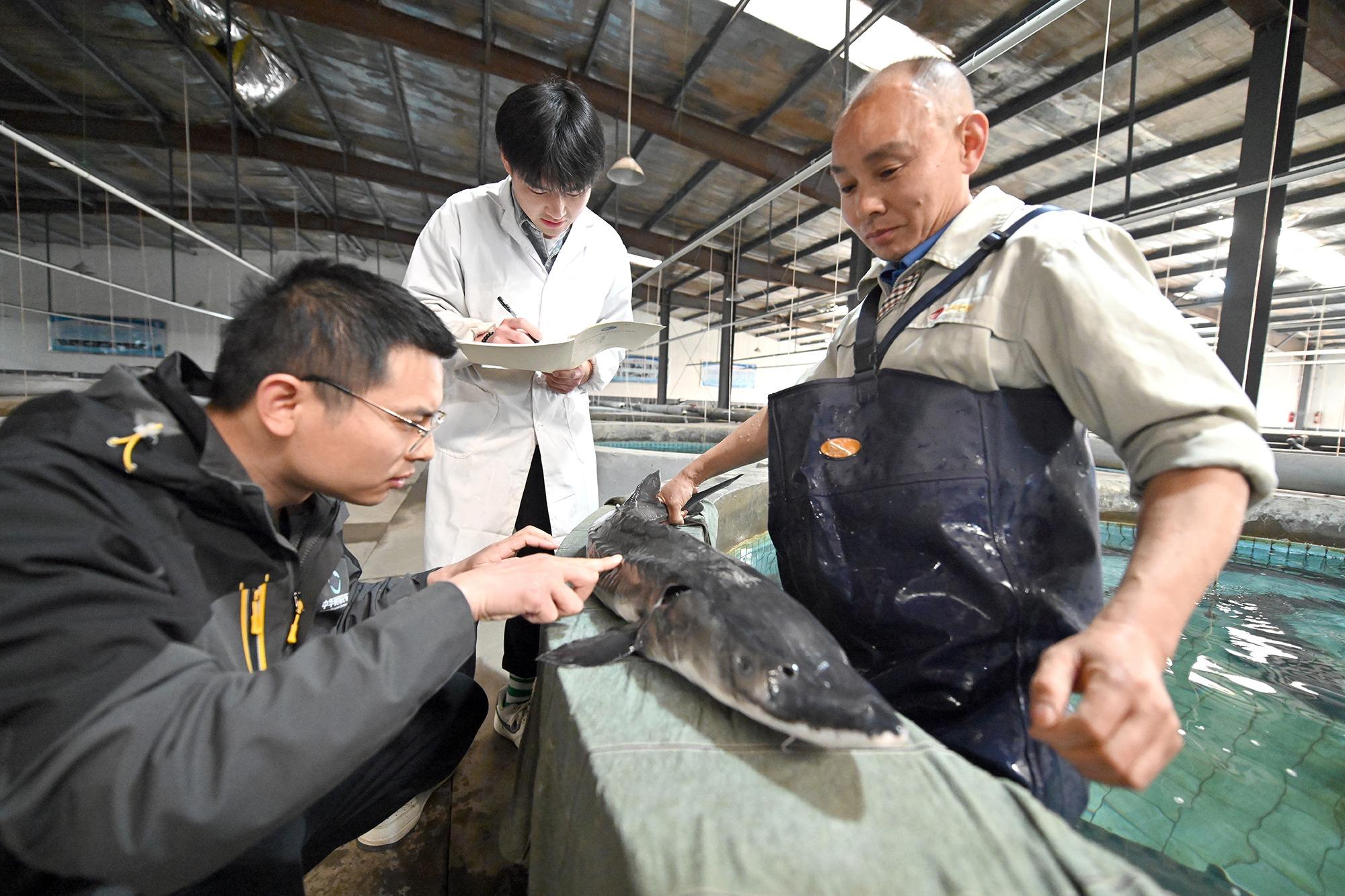 Researchers tag an artificially bred Chinese sturgeon that is about to be released into the wild in Jingzhou, Hubei, on March 28, 2023. (DENG JIA / FOR CHINA DAILY)
Researchers tag an artificially bred Chinese sturgeon that is about to be released into the wild in Jingzhou, Hubei, on March 28, 2023. (DENG JIA / FOR CHINA DAILY)
Early efforts
Established in 1982, the institute, an affiliate of China Three Gorges Corp, is tasked with monitoring the level of biodiversity in the waters near the dam, the world's largest hydropower facility.
The sturgeon-releasing event, held in the lead-up to the International Day for Biological Diversity on May 22, was part of a broader and long-running effort by authorities to repair the ecology of the Yangtze. Strained by factors such as overfishing, pollution and the environmental consequences of dams and hydropower plants, the wild sturgeon population has shrunk to dangerously low levels, prompting artificial breeding efforts and the rise of release events.
The fish population in the river — and the fishery harvests — fell in the early years of the People's Republic of China, which was founded in 1949. The construction of dams and hydropower infrastructures, such as the Three Gorges Dam, on the Yangtze is one of a number of factors contributing to the decline. The human structures altered the river's flow, reduced connectivity and raised concerns among the nation's scientific community about the well-being of the species, experts said.
Wei Qiwei, an aquatic product researcher at the Chinese Academy of Fishery Sciences in Beijing, said that an estimated 10,000 Chinese sturgeons lived in the Yangtze in the 1960s. The population fell to just over 2,000 in the 1980s, then just 50 in 2005.
"There are only about a dozen wild Chinese sturgeons living in the Yangtze at present," he said in an interview with China National Radio in March last year.
Jiang, the chief engineer, said that in the 1960s, concerns were mainly focused on the well-being of four species that were critical to local fishing industry.
After construction started in 1971 on the Gezhouba Dam, a sprawling water-control facility and hydroelectric power station on the Yangtze's mainstream, the fate of the Chinese sturgeon and several other noncommercial species attracted great attention.
"At the time, China had not established a system that required major projects to be vetted for their environmental impact, and the creation of the Gezhouba Dam spurred a lot of research and discussion among scientists," Jiang said.
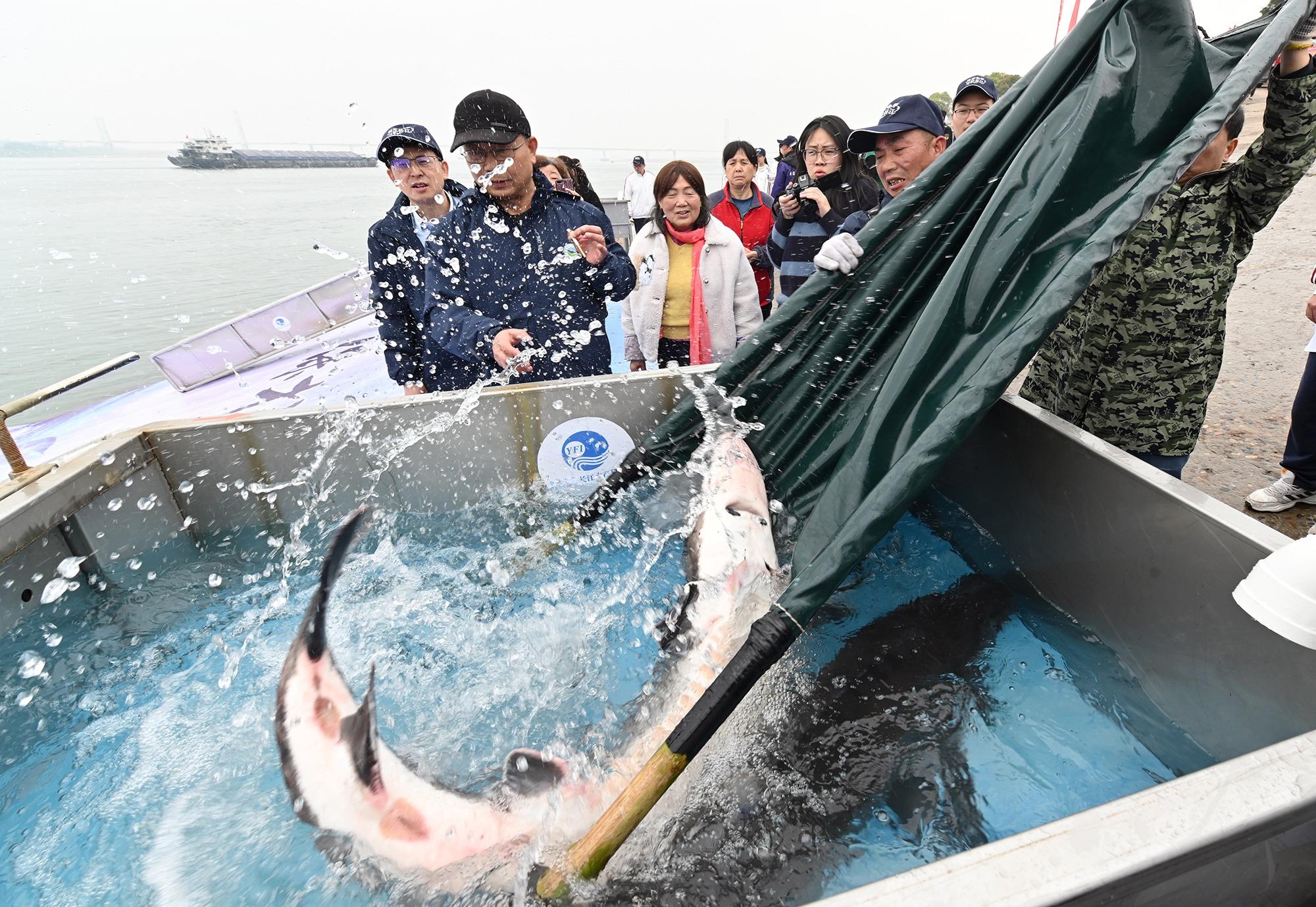 Chinese sturgeons are ready to be released into the Yangtze River in Jingzhou on March 28, 2023. (DENG JIA / FOR CHINA DAILY)
Chinese sturgeons are ready to be released into the Yangtze River in Jingzhou on March 28, 2023. (DENG JIA / FOR CHINA DAILY)
In the years that followed, researchers from the Chinese Academy of Sciences and other research bodies discovered that fish species of high economic value — such as the grass and silver carp — were highly adaptable and minimally affected by the dam. They quickly formed new spawning grounds. Therefore, experts decided that the rescue efforts should be directed elsewhere.
The Chinese sturgeon and some other migratory species were not so lucky. The ancient fish spend most of their lives in the ocean but return to freshwater areas to reproduce. They embark on long journeys to reach their spawning grounds in the middle reaches of the Yangtze during the spring and summer months, when the females release eggs into the river while the males release sperm to fertilize them.
The fertilized eggs then drift downstream, where they develop into free-floating larvae. These young sturgeons eventually settle onto the riverbed and continue to grow before eventually migrating back to the ocean.
However, the Gezhouba Dam and other infrastructure partially disrupted the process. Before the Gezhouba Dam prevented fish on both sides of the facility from accessing the upstream and downstream parts of the Yangtze River in 1981, there were 16 spawning grounds spread across the Yangtze and its tributary, the Jinsha River. In 1981, only one spawning ground was discovered downstream of the Gezhouba Dam.
In 1982, naturally spawned young sturgeons were spotted in the waters near the dam, showing that the fish still managed to reproduce despite the new dam disrupting their migration path. Therefore, authorities abandoned an expensive plan to open a migratory pass through the dam and settled on more affordable conservation methods that could deliver immediate results, such as releases of fish, the creation of conservation zones and the imposition of fishing bans.
The same year, the Ministry of Water Resources established a body to carry out the releases, which later became the Chinese Sturgeon Research Institute, Jiang's employer.
"The institute is the first of its kind in the country, and it has gradually morphed into the backbone of the protection of the endangered Yangtze River fish species," he said.
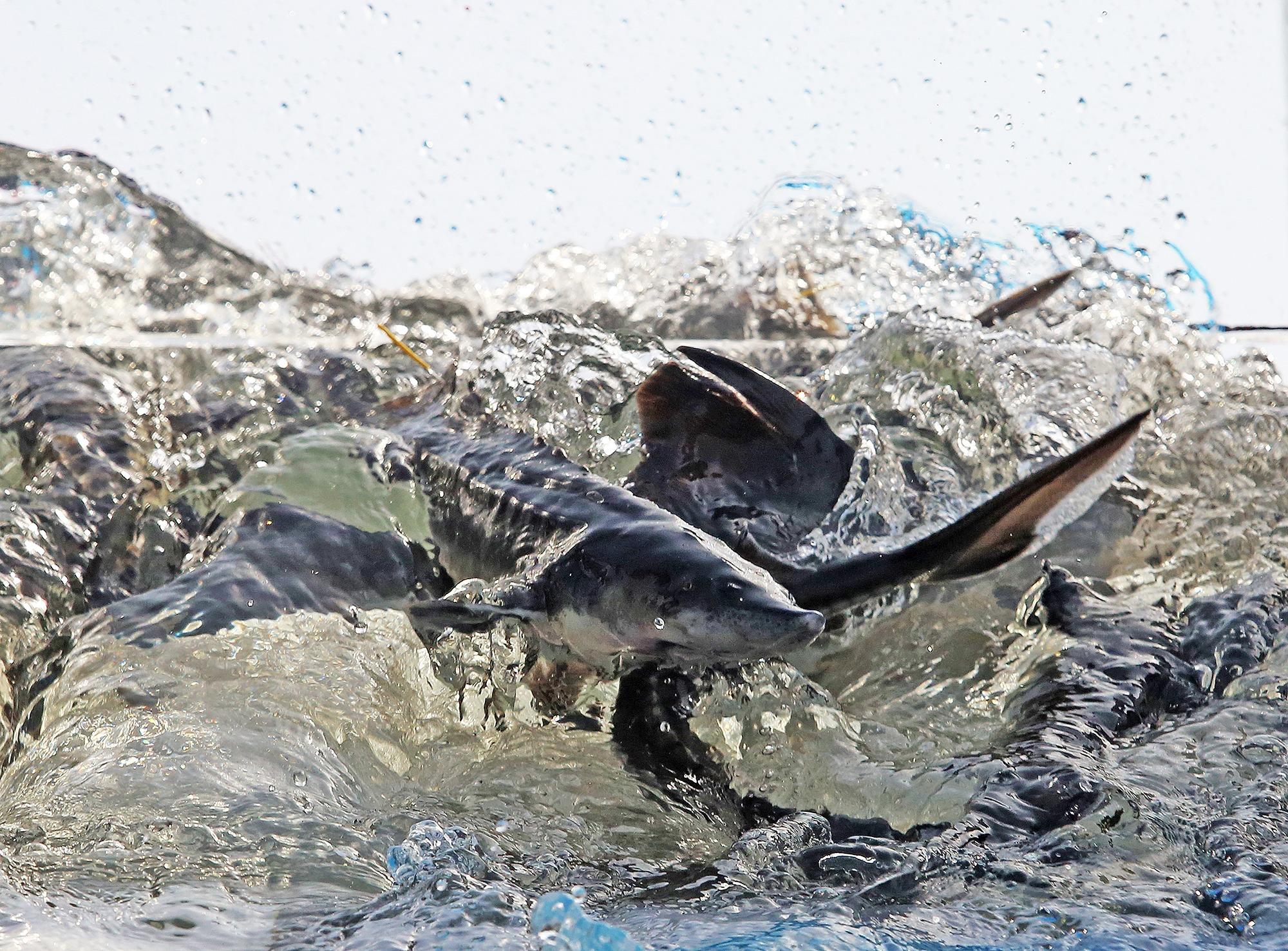 Artificially bred Chinese sturgeons swim in the Yangtze River in Yichang, Hubei province, in this file photo taken on April 12, 2015. (LI XINFENG / FOR CHINA DAILY)
Artificially bred Chinese sturgeons swim in the Yangtze River in Yichang, Hubei province, in this file photo taken on April 12, 2015. (LI XINFENG / FOR CHINA DAILY)
Trial and error
The releases were easier said than done. In the early days, the survival rate of freed sturgeons was stubbornly low. Immature breeding techniques meant researchers had to release newly spawned fish as quickly as possible, even before they were old enough to fend for and feed themselves in natural waters.
Jiang said in 1985 his predecessors started researching the sturgeon's breeding techniques with almost no literature available.
Over the ensuing decade, they figured out the crucial factors affecting the well-being of the young fish being raised in captivity, such as food and water temperature and quality. They also worked on experiments to prevent the spread of deadly fish diseases. "In 1995, the body length of the released fish had reached more than 30 centimeters and their survival rate in the wild rose," Jiang said.
The progress in breeding knowledge also meant that the young sturgeons became sexually mature in captivity and provided sperm and eggs for human-controlled reproduction. That eased the strain on the wild population of adult sturgeons, which were caught to harvest sperm cells and eggs.
"In 2009, the institute managed to incubate young sturgeons using sperm and eggs from domestically bred parents. That was a milestone because it meant we had managed to breed sturgeons with no reliance on the wild species," Jiang said.
In recent years, Jiang and his colleagues have used gene-sequencing technologies to prevent breeding among close relatives, which can harm genetic diversity and increase vulnerability to disease.
"With the genetic data, we are now able to match sperm and eggs in the best possible ways to ensure genetic diversity," he said.
He added that the decadelong fishing ban imposed on the Yangtze has proved a boon for sturgeon releases and other efforts to replenish the fish population.
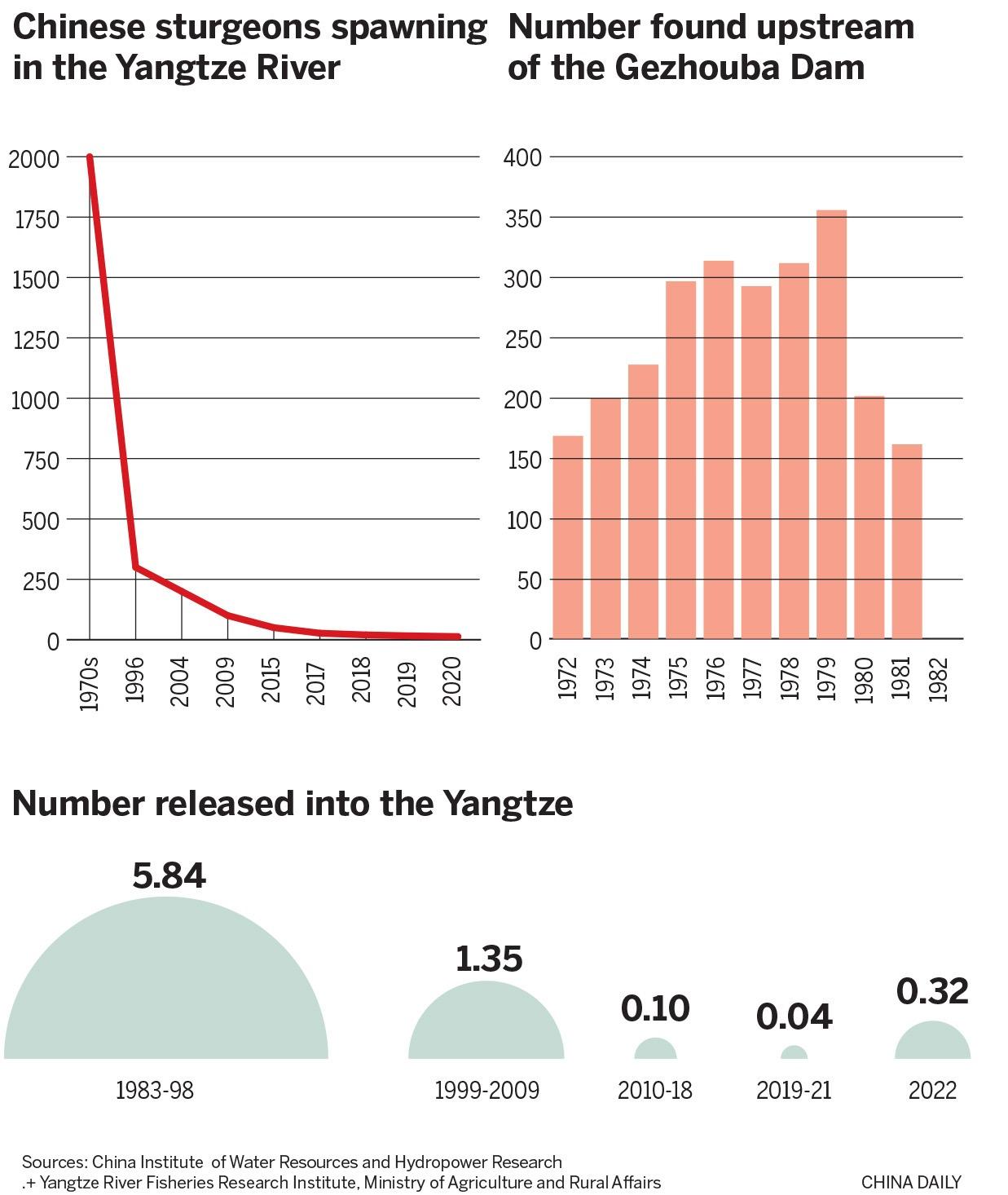
Struggle for survival
Wei Qiwei, the fishery scientist, said release work is crucial to restoring the sturgeon population in the wild, but the number of released young sturgeons that can actually survive in the Yangtze is small compared with the total released.
"Only scores of young sturgeons out of some 50,000 can do that," he said.
More than four decades on, the release task force is placing more emphasis on the work's results by stepping up evaluation and research that helps scientists understand the sturgeon's living habits.
"We are now studying the fish's footprint in the ocean, how they migrate in the Yangtze and the effectiveness of the release work carried out in the Jinsha River," Wei said, referring to a tributary of Yangtze River in its upper reaches.
Last year, the Ministry of Agriculture and Rural Affairs rolled out a guideline specifying the species and locations eligible for fish releases, with the aim of stamping out invasions of alien species.
Jiang said the scale of the release work will continue to be expanded during the period of the 14th Five-Year Plan (2021-25), in hopes of reaching 1 million annually before the period ends.
Statistics provided by the China Three Gorges Corp show that the company had released 21 million endangered fish — including the largemouth bronze gudgeon and 6 million Chinese sturgeons — into the Yangtze since it was founded some 30 years ago.
In addition, the company has relocated 1,390 plant species that made way for the dam's construction. Jiang said that the central authorities underscored greener development and harmonious coexistence between humanity and nature at the 20th National Congress of the Communist Party of China convened in mid-October in Beijing last year.
"That has given the company a new mission," he said.
Luo Jiayuan contributed to this story.
Contact the writers at lilei@chinadaily.com.cn



